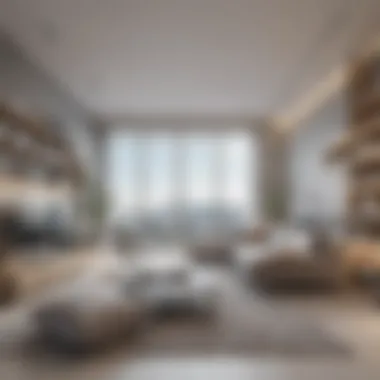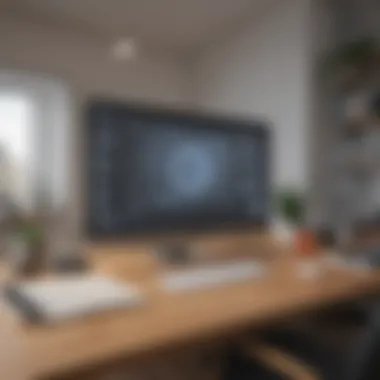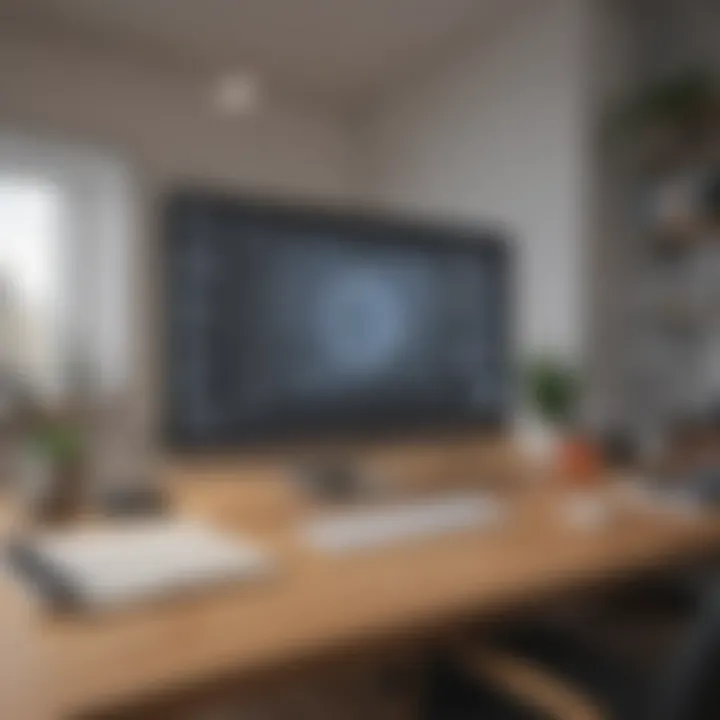In-Depth Review of Room Rendering Software Solutions


Intro
The domain of room rendering software has come to the forefront in architectural design and visualization. These tools play a crucial role in how architects, interior designers, and other industry professionals present their ideas. With technological advancements, the significance and functionality of these applications have evolved, offering more sophisticated features to enhance the visualization process.
Investing in the right room rendering software is essential for small to medium-sized businesses and entrepreneurs who need to communicate design concepts effectively. In this article, we will explore the various types of room rendering software available in the market, their core functionalities, and unique selling points.
Key Features of the Software
Room rendering software provides essential tools to transform 2D drawings into immersive 3D visualizations. Understanding the key features helps users navigate through the available options to find solutions that meet their specific requirements.
Overview of Core Functionalities
The core functionalities of room rendering software often include:
- Realistic rendering: Ability to create high-quality images that accurately depict materials, lighting, and textures.
- Spatial visualization: Provides users with a three-dimensional view of spaces, allowing for better understanding of dimensions and proportions.
- Interactive design tools: Users can modify designs in real-time, making it easy to experiment with color, materials, and layout.
- Collaboration features: Many applications offer cloud-based solutions to allow multiple users to work on a project simultaneously.
- Export options: The capability to export designs into various formats can facilitate presentations and sharing with clients.
Unique Selling Points
Different rendering software has unique selling points to attract users. Some notable aspects include:
- User-friendly interface: Software like SketchUp is known for its intuitive design, making it accessible for beginners.
- Compatibility: Programs that seamlessly integrate with popular CAD tools or other design software can enhance workflows.
- Cost-effectiveness: Some tools, such as Blender, offer robust features at no cost, appealing to startups and smaller firms.
In-Depth Software Analysis
A critical evaluation of these tools involves weighing their pros and cons as well as examining performance metrics. This analysis will guide users in selecting the ideal software solution.
Pros and Cons
The advantages and disadvantages of room rendering software vary among the different tools. Users must consider:
Pros:
- High-quality visualizations can attract clients and stakeholders.
- Expected improvements in efficiency and productivity.
- Access to a diverse library of textures and materials.
Cons:
- Some tools can be expensive, impacting budgets of smaller businesses.
- A steep learning curve may discourage users without a design background.
- Rendering times can vary significantly based on rendering complexity and hardware performance.
Performance Metrics
When analyzing room rendering software, performance metrics provide valuable insight into usability and effectiveness. Important considerations include:
- Rendering speed: The time taken to generate images is critical, especially under tight project deadlines.
- System requirements: Understanding the necessary hardware specifications can prevent compatibility issues.
- Customer support availability: Accessible support resources can enhance user experiences and foster better understanding of the software features.
As technology continues to evolve, businesses must stay informed about emerging trends in room rendering software to remain competitive and meet client expectations.
Prologue to Room Rendering Software
Room rendering software plays an essential role in the architectural visualization process. This software enables users to create, modify, and visualize space before physical construction occurs. Understanding room rendering software is vital for professionals in fields like architecture, interior design, and real estate.
The primary significance of this software lies in its ability to transform abstract concepts into tangible images. For small to medium-sized businesses and entrepreneurs, presenting a clear visualization of projects is crucial. It aids in decision-making, fund allocation, and client persuasion, which can significantly impact business success.
The benefits of room rendering software include:
- Enhanced visual appeal: High-quality renderings capture attention and provide a realistic sense of space.
- Improved communication: Renderings facilitate discussions among team members, clients, and stakeholders, clarifying concepts that may be difficult to convey through words alone.
- Time-saving capabilities: Quick alterations in design can be visualized instantly, allowing for more efficient workflows.
- Increased client satisfaction: Clients appreciate having a clear visual representation of the final product, leading to increased trust and understanding.
Considerations in adopting room rendering software involve evaluating user needs, budget constraints, and the specific features required. An understanding of different software types—like 2D, 3D, and virtual reality options—enhances the selection process. Furthermore, professionals must consider how integration with existing tools will affect overall usability and compatibility.
Room rendering software sits at the intersection of technology and creativity, and its importance continues to grow as industries evolve towards more visual solutions. This article will explore the definition, purpose, features, and various types of room rendering software, helping stakeholders make informed decisions for their specific visualization needs.
Definition and Purpose
Room rendering software plays a critical role in various fields by enabling professionals to create realistic visual representations of spaces. This technology not only enhances the design process but also serves multiple practical applications. In this section, we will delve into the significance of room rendering software and its overarching purpose, discussing its essential elements and the benefits it brings to the table.
Understanding Room Rendering
Room rendering refers to the process of generating visual representations of environments, which can be either two-dimensional or three-dimensional. Through advanced algorithms and graphical techniques, this software creates images that are often indistinguishable from real photographs. For architects, designers, and real estate agents, these visualizations provide a powerful medium to communicate concepts, ideas, and proposals clearly. Successful rendering allows stakeholders to visualize space effectively before any actual construction or renovation takes place.
Applicability in Various Fields
Room rendering software is not limited to a single industry; it has significant applications across multiple domains. Below are the key fields that benefit from this technology:
Architecture


In architecture, room rendering is crucial for conceptualizing and presenting design ideas. Architects can utilize rendering software to develop highly detailed and accurate visualizations of their projects, enabling clients to see end results long before construction. The ability to create immersive experiences helps architects convey complex ideas effectively, which facilitates better communication with clients. However, the initial learning curve associated with these tools can be challenging for newcomers to overcome.
Interior Design
Interior designers employ room rendering software to visualize enhancements in existing spaces. This software allows them to simulate different colors, materials, and layouts, making it essential for client approval processes. Designers benefit from the ability to present multiple options quickly, increasing client satisfaction and expediting decision-making processes. However, reliance on software quality can produce varying results, leading to inaccuracies if not used diligently.
Real Estate
In the real estate industry, room rendering software can significantly influence buyer decisions. Real estate agents utilize these tools to create virtual walkthroughs and high-quality images that showcase properties effectively. This visual appeal often leads to quicker sales and increased interest. Additionally, virtual staging can enhance listings at a fraction of traditional staging costs. Yet, potential buyers may sometimes doubt the accuracy of renderings, necessitating transparency in visual representation to manage expectations.
"Room rendering software enables stakeholders to visualize design options, allowing informed decision-making before any physical changes are made."
By exploring these fields more closely, we notice the dynamic capabilities of rendering software. Each discipline leans on room renderings to transform concepts into compelling visuals, thereby showcasing the significant impact of this technology in advancing design and sales processes.
Key Features of Room Rendering Software
Room rendering software has transformed how architects, designers, and real estate professionals visualize spaces. The key features of such software play a crucial role in delivering quality visual content. Understanding these features helps users make informed decisions about the tools that suit their specific needs and workflows. Here, we will examine three pivotal features: realistic visualizations, user-friendly interface, and integration with other tools.
Realistic Visualizations
Realistic visualizations are perhaps the most significant element of room rendering software. Users expect outputs that closely resemble real-world interactions. This accuracy is essential for effective communication among clients, stakeholders, and project teams. High-quality renderings can portray not only the visual aspects but also the textures, colors, and lighting of a space. Programs that utilize ray tracing technology can create shadows and reflections that enhance realism.
Additionally, realistic visualizations allow for immersive experiences. Users can provide clients with visual walkthroughs, which helps in understanding spatial arrangements. This capability reduces errors in later stages of a project and can lead to higher client satisfaction. With detailed renderings, feedback is more straightforward, which accelerates decision-making processes.
User-Friendly Interface
The user interface (UI) of room rendering software is another critical feature. A well-designed UI can significantly enhance the user's workflow and productivity. For small to medium-sized businesses, where efficiency is key, the importance of a user-friendly interface cannot be overstated. Clear menus, intuitive controls, and easy navigation ensure that users can focus on creative tasks rather than struggling with complex software functions.
Training times are also influenced by the quality of the UI. A straightforward layout can minimize the learning curve for new users. This is especially vital in an industry where time is money. Freelancers and small teams often operate under tight deadlines, making ease of use a priority. Having a user-friendly interface enables team members to quickly contribute to projects without extensive training.
"Accessible design streamlines workflows and fosters greater creativity."
Integration with Other Tools
The capability to integrate with other software tools is a key feature that enhances the utility of room rendering software. Many professionals utilize multiple applications in their workflows. Thus, having software that can work seamlessly with drawing tools such as AutoCAD or project management software like Trello improves productivity.
Integration also allows for better data sharing. For example, if an architect uses SketchUp for design and Lumion for rendering, being able to transfer designs efficiently between the two minimizes redundancy. This interconnectedness leads to optimized project cycles, reducing turnaround times.
The importance of file compatibility cannot be overlooked. Utilizing software that supports various file types makes it easier for teams to collaborate. This feature is particularly valuable when teams consist of diverse professionals who may use different tools. Integration capabilities ultimately enhance the flexibility and scalability of room rendering software, allowing businesses to adopt a more holistic approach in their projects.
Types of Room Rendering Software
The evolution of room rendering software has led to the development of various types tailored to specific needs and applications. Understanding the different types is essential for businesses and professionals looking to enhance their architectural visualization capabilities. Each type of software brings unique features and benefits that cater to different project requirements. The three primary categories are 2D rendering software, 3D rendering software, and virtual reality integration.
2D Rendering Software
2D rendering software plays a crucial role in creating flat designs and layouts for room visualization. This type of software is ideal for projects where space planning is the primary focus, rather than depth and detail. Users can create floor plans, elevations, and detailed drawings with relative ease.
Some of the key benefits of 2D rendering software include:
- Simplicity of Use: Most 2D tools have straightforward interfaces, making them accessible to users without extensive design experience.
- Cost-Effective: Often, 2D software is more affordable than its 3D counterparts, making it a budget-friendly option for small businesses.
- Speed of Production: It allows for quick adjustments and iterations, enabling designers to experiment with layouts efficiently.
Moreover, software like AutoCAD and Floorplanner allows for integration with other design applications, offering a seamless workflow for professionals.
3D Rendering Software
3D rendering software offers a more immersive experience by providing three-dimensional visualizations of rooms and spaces. This category of software is vital for projects that require a realistic presentation of architectural designs.
The advantages of 3D rendering software include:
- Realistic Representations: High-quality textures and lighting effects create lifelike images that help clients visualize the final outcome.
- Enhanced Detail: Users can manipulate designs to see how different elements interact with one another, allowing for better design decisions.
- Virtual Walkthroughs: Many 3D rendering tools offer features that let users experience a space as if they were physically present, which is invaluable for presentations.
Prominent programs in this category, like SketchUp and Lumion, provide various functionalities essential for real-time rendering and dynamic model updates.
Virtual Reality Integration
Virtual reality (VR) integration is an emerging trend in room rendering software, allowing designers and clients to experience spaces in an interactive environment. This type of software goes beyond traditional rendering and provides a hands-on experience.
Key points regarding virtual reality integration include:
- Immersive Experience: VR creates a unique experience by allowing users to literally step into the design, which can enhance client presentations significantly.
- Better Decision-Making: Experiencing a design in VR aids in understanding scale and proportions better than any flat screen can offer.
- Collaborative Possibilities: This technology fosters collaboration among teams, as multiple users can share experiences in a virtual space, regardless of location.
While currently more specialized, programs like Enscape and IrisVR are leading the way in integrating VR into room rendering, setting standards for the industry.


Understanding the types of room rendering software available and their respective strengths can significantly influence the success of visualization projects. Each type serves a distinct purpose and can be chosen based on specific requirements. Integrating the right software into the design process can streamline workflows and enhance the overall quality of architectural presentations.
Evaluating Popular Room Rendering Software
Evaluating the popular room rendering software is crucial for individuals and businesses aiming to enhance their architectural visualization processes. The right software can significantly impact the quality of visualizations, time efficiency, and client satisfaction. Different software offer unique features, usability, and pricing options that cater to varying needs. Thus, taking the time to assess these options ensures that users select a tool that aligns with their project requirements and budget constraints.
AutoCAD
AutoCAD is one of the most recognized tools in the design and engineering sector. It stands out for its powerful drafting capabilities and extensive features that can be tailored to various industries, including architecture and engineering. The software provides precision in 2D drafting, allowing users to create detailed floor plans with ease. In recent years, AutoCAD has integrated enhanced 3D rendering tools, which allow users to visualize their designs in a more realistic context.
One of the key advantages of AutoCAD is its compatibility with other Autodesk products. This seamless integration makes it easier to evolve designs and collaborate across teams. However, the software may come with a steep learning curve for newcomers, and the licensing costs can be significant, especially for small businesses.
SketchUp
SketchUp offers a more intuitive environment for users who may not have advanced technical skills. It is particularly popular because of its user-friendly interface, which provides a gentle learning curve for beginners. The drag-and-drop functionality, combined with a variety of pre-loaded 3D models, allows for faster project development. Users appreciate the ability to create quick renderings, making it ideal for brainstorming sessions and early design stages.
Moreover, SketchUp promotes collaboration through its online platform, SketchUp for Web. This feature allows users to share their designs and receive feedback in real-time. However, while it serves well for basic projects, more complex modeling may expose limitations in its rendering capacity compared to software like AutoCAD.
Lumion
Lumion is distinct for its focus on rendering speed and realism. It is intended primarily for architects seeking to create high-quality visualizations in a short timeframe. With an extensive library of objects, materials, and effects, Lumion allows for compelling presentations that engage clients without requiring lengthy setup. The software supports real-time rendering, which means changes can be viewed immediately.
The learning curve for Lumion is relatively low, making it approachable for professionals who may not be well-versed in rendering practices. However, users must consider the strong hardware requirements; it necessitates a robust graphics card to achieve optimal performance. Furthermore, while Lumion excels in its presentation capabilities, it may fall short in terms of detailed modeling compared to AutoCAD or SketchUp.
Choosing the right room rendering software necessitates consideration of the specific needs of a project and available resources.
This evaluation illustrates how each software caters to different user requirements. A careful analysis of these tools enables professionals to select the best fit for their projects, ensuring effective and satisfying outcomes.
Factors to Consider When Choosing Software
Selecting the right room rendering software involves a careful evaluation of multiple facets. This section underscores the importance of various elements, emphasizing how they can fundamentally impact the success of projects. A well-informed choice not only enhances productivity but also aligns with the unique needs of small to medium-sized businesses and individual professionals. Here are three critical factors to keep in mind.
Budget Constraints
Budget plays a crucial role in the selection process. Given the variety of software available, prices can vary significantly. On one hand, there's premium software that offers advanced features, and on the other, there are budget-friendly options that meet basic needs.
- Cost-Benefit Analysis: Evaluate the features against the price. Sometimes, spending more can yield better long-term results.
- Total Cost of Ownership: Beyond the initial cost, consider subscription fees, upgrade costs, and additional expenses like training or support services.
- Availability of Free Trials: Many software providers offer free versions or trials, allowing users to test functionality before making financial commitments.
Taking time to assess budget constraints ensures that the chosen software delivers value without imposing financial strain.
Specific Features Required
Understanding the specific needs of your projects influences the software choice significantly. This is where clarity about required functionalities becomes essential. Not all software offers the same features, so knowing what aspects are vital ensures a more tailored selection.
- Rendering Quality: Determine the necessary quality of visual output based on your target audience. Some users may require high-definition renders, while others may only need simpler visuals.
- Compatibility with Existing Tools: Assess how well the software integrates with other applications you currently use, such as architectural tools or project management platforms.
- Customization Capabilities: Some software allows necessary modifications or the addition of plugins, which can enhance functionality as requirements evolve over time.
Carefully identifying specific features minimizes the risk of selecting software that is either lacking in essential functions or overly complicated for simple tasks.
User Support and Resources
Access to support and additional resources are crucial for smooth operation, especially when working with complex software. Dependable options can make a significant difference in user experience.
- Training and Tutorials: Availability of comprehensive guides and tutorials can accelerate the learning curve, enabling users to utilize the software effectively.
- Customer Support Services: Look for providers that offer responsive customer support, whether via chat, email, or phone. Issues can arise unexpectedly, and having quick access to help is invaluable.
- Community Forums and User Groups: Engaging with a community can provide insights, tips, and collaborative solutions. Platforms like Reddit can be excellent for discussing shared experiences with the software.
Being mindful of user support and resources enhances the overall efficiency and effectiveness of using room rendering software.
Overall, considering these factors ensures that the software selected aligns well with both your budget and specific project needs, thereby maximizing productivity.
Potential Challenges in Implementation
Implementing room rendering software can come with its own set of challenges. Understanding these challenges is important for businesses, particularly small to medium-sized enterprises and entrepreneurs. Knowing what obstacles may arise helps these companies prepare for them effectively. The aim is to minimize disruptions and ensure a smooth integration of the software into existing workflows.
Learning Curve
One significant challenge is the learning curve associated with room rendering software. Different tools have unique interfaces and functionalities. For users who are not familiar with these applications, it can take time to develop proficiency. Companies must invest time in training their employees, which may divert focus from core activities. It is essential to plan adequate training sessions to familiarize the staff with the software. Additionally, providing access to resources, such as online tutorials or workshops, can ease this transition.
Compatibility Issues
Another potential problem is compatibility with existing systems. Many businesses use a variety of software programs for different tasks. Room rendering software should ideally integrate seamlessly with these applications. However, compatibility issues can surface, leading to additional challenges. These issues can cause delays and increase the workload. It is wise to conduct a thorough compatibility assessment before adopting new software. This ensures that the chosen tools will operate well with the current technology stack, reducing the risk of interruptions.
Hardware Requirements


Lastly, hardware requirements often play a critical role in the implementation of room rendering software. Advanced rendering tasks may require high-performance computers with specific graphic capabilities. Insufficient hardware can lead to poor application performance. This not only frustrates users but also limits the software’s potential. Businesses should evaluate their current hardware infrastructure before implementing any software. Upgrading hardware may be necessary to meet software demands. This factor should be included in budget considerations to avoid unexpected costs later on.
In summary, navigating these challenges is crucial for the successful integration of room rendering software into a business environment. Proper training, ensuring system compatibility, and addressing hardware needs should be prioritized during implementation.
Best Practices for Effective Use
Using room rendering software effectively requires a systematic approach. In this section, we explore several best practices that can significantly enhance the user's experience and output quality. By adapting these practices, businesses can optimize their workflow and ensure they are getting the most out of their software tools.
Setting Up Your Workspace
A well-organized workspace is crucial for effective use of room rendering software. This includes both physical and digital spaces. Start by configuring your computer or laptop with adequate hardware specifications that meet the demands of the software. Recommended specifications typically include ample RAM, a dedicated graphics card, and sufficient storage space.
Additionally, organize your digital files. Create folders for different projects, assets, or resources. Use clear naming conventions to locate files easily, avoiding clutter and confusion over time. This setup minimizes distraction and increases productivity.
Regular Software Updates
Keeping your room rendering software updated is essential. Updates often include bug fixes that improve stability and performance. Moreover, new features and enhancements become available with updates, allowing users to have access to the latest capabilities in visualization technology.
Check for updates regularly or enable automatic updates if available. This practice ensures that your software runs smoothly and includes the latest tools to aid your design efforts.
Utilizing Support Channels
Maximizing the benefits of room rendering software also involves knowing where to seek help when needed. Most software providers have support channels which can include forums, documentation, or customer service. Utilizing these resources effectively can save time and reduce frustration when facing technical challenges.
Engage with online communities such as Reddit or Facebook groups focused on rendering software. These platforms provide valuable insights from other users, enabling you to learn tips and tricks that can enhance your skills.
"An active community can be a great resource to troubleshoot problems and share innovative usage methods.”
By following these best practices, businesses can better navigate the complexities of room rendering software, leading to improved results and a more streamlined workflow.
Future Trends in Room Rendering Software
As the world of technology continues to evolve, room rendering software experiences significant advancements that reshape architectural visualization processes. Recognizing these future trends is crucial not only for enhancing design capabilities but also for meeting the changing demands of the market. By embracing innovations such as artificial intelligence, better collaboration tools, and sustainable practices, businesses can significantly improve their workflows and project outcomes. Each of these elements contributes to augmenting productivity, facilitating superior client engagement, and fostering environmental responsibility in design.
Artificial Intelligence and Automation
Artificial intelligence plays a pivotal role in room rendering software's future. AI can streamline several processes that otherwise require substantial manual input. For instance, AI algorithms can analyze previous design projects to suggest improvements or variations. This capability reduces the time designers need to spend on brainstorming and allows them to focus more on creative aspects.
Moreover, automation within software can convert manual tasks into automatic functions. This includes lighting adjustments, material applications, and even the generation of realistic environments. As designers input their initial concepts, AI-driven tools can auto-generate options based on existing data, considerably speeding up the design cycle.
Adopting AI also provides an opportunity for deep learning. Enhanced algorithms learn from user behavior and preferences over time, making recommendations that suit specific styles or requirements. Such features enable an adaptive and personalized user experience that places the designer in a more empowered position.
Enhanced Collaboration Features
Collaboration becomes increasingly important in project development, and room rendering software must evolve to meet this need. Enhanced collaboration features allow stakeholders to work together seamlessly, irrespective of geographical limitations. Tools like real-time project sharing and cloud storage facilitate instant feedback, ensuring that all team members stay aligned on design intents.
Modern software integrates communication channels directly within the interface, permitting quick discussions on changes or modifications. This feature can greatly reduce email exchange, keeping all conversations contextual and accessible.
Furthermore, versions control allows designers to track all changes made throughout the project lifecycle. This ensures that all contributors can refer back to previous iterations if necessary, creating a comprehensive audit trail. This transparency is essential for ensuring accountability and facilitating productive teamwork.
Sustainability in Design
As the focus on environmental responsibility grows, so does the importance of sustainability in room rendering software. Future advancements will likely include features that prioritize eco-friendly practices. These may encompass tools that analyze resource efficiency, promoting designs that minimize energy consumption and waste.
Sustainable features can also extend to material selection. Software might integrate databases that provide information about sustainable materials and their impacts, helping designers make informed choices. Contemplating the lifecycle of building materials ensures that every element contributes positively to environmental goals.
"Staying ahead in technology is a non-negotiable aspect of effective design in today’s rapidly changing market."
Closure and Recommendations
In any exploration of room rendering software, reaching the conclusion stage holds significant value. Here, we synthesize the critical insights gathered throughout the article. Understanding the nuances of this software is essential for businesses aiming to improve their architectural visualization capabilities.
Room rendering software serves varied interests, from architects to interior designers and real estate professionals. Therefore, recognizing the software's applicability in a business context is vital. A sophisticated understanding can lead to better project outcomes and superior client satisfaction. Selecting the right tool can affect efficiency, reduce costs, and enhance quality.
Key Elements to Consider
Several factors merit careful consideration before making a final decision on room rendering software:
- User Experience: A user-friendly interface often aids adoption. Complex software can deter teams from utilizing them fully.
- Budget Efficiency: Acquiring software is an investment. Evaluating what features are essential can prevent overspending.
- Support and Resources: Access to customer support can alleviate problems during the learning curve. Ensure that adequate training resources are available.
Recommendations for Small to Medium-Sized Businesses
- Thorough Research: Analyze multiple tools and read reviews from fellow professionals in your field. Visit forums like Reddit, or consult articles on platforms such as Wikipedia and Britannica to gain a comprehensive understanding.
- Trial Versions: Many companies provide trial periods for their software. Utilize this to gauge compatibility with your workflow before purchasing.
- Scalability: Choose software that accommodates growth. Small businesses should consider whether the software can evolve with their needs.
- Collaborative Features: As projects often involve multiple parties, software that supports collaboration may significantly enhance communication and efficiency.
In summary, the recommendation process should be meticulous. It is not merely about selecting software, but rather choosing a partner in visualization.
"Selecting room rendering software can substantially influence project quality and team performance."
By keeping these elements in mind, businesses can make informed choices that lead to successful project execution and enhance overall productivity.















